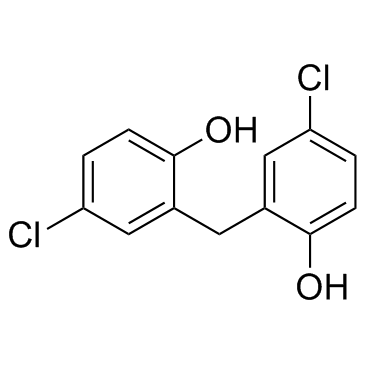Dichlorophen

Dichlorophen structure
|
Common Name | Dichlorophen | ||
|---|---|---|---|---|
| CAS Number | 97-23-4 | Molecular Weight | 269.123 | |
| Density | 1.4±0.1 g/cm3 | Boiling Point | 418.7±40.0 °C at 760 mmHg | |
| Molecular Formula | C13H10Cl2O2 | Melting Point | 168-172 °C(lit.) | |
| MSDS | Chinese USA | Flash Point | 207.0±27.3 °C | |
| Symbol |


GHS07, GHS09 |
Signal Word | Warning | |
|
Non-animal photosafety screening for complex cosmetic ingredients with photochemical and photobiochemical assessment tools.
Regul Toxicol Pharmacol 72 , 578-85, (2015) Previously, a non-animal screening approach was proposed for evaluating photosafety of cosmetic ingredients by means of in vitro photochemical and photobiochemical assays; however, complex cosmetic ingredients, such as plant extracts and polymers, could not b... |
|
|
Rational design of indoleamine 2,3-dioxygenase inhibitors.
J. Med. Chem. 53 , 1172-89, (2010) Indoleamine 2,3-dioxygenase (IDO) is an important therapeutic target for the treatment of diseases such as cancer that involve pathological immune escape. We have used the evolutionary docking algorithm EADock to design new inhibitors of this enzyme. First, w... |
|
|
Identification of estrogenic compounds in fish bile using bioassay-directed fractionation.
Environ. Sci. Technol. 38(23) , 6415-23, (2004) Conjugates of estrogenic chemicals, endogenous as well as xenobiotic, are mainly excreted via bile into the intestine. Therefore, measurement of estrogenic activity in bile yields useful information about an organism's internal exposure to (xeno-)estrogens. A... |
|
|
Toxicological profile for o-benzyl-p-chlorophenol.
J. Appl. Toxicol. 18(4) , 271-9, (1998) As part of a health-hazard survey on the health risk of hospital cleaning workers from exposure to Lyorthol, a hazard assessment of o-benzo-p-chlorophenol, one of the constituents of Lyorthol, has been prepared. In this paper, the physical and chemical charac... |
|
|
Ecotoxicological evaluation of the biocidal agents sodium o-phenylphenol, sodium o-benzyl-p-chlorophenol, and sodium p-tertiary amylphenol.
Ecotoxicol. Environ. Saf. 60(2) , 203-12, (2005) The ecotoxicological effects of three biocidal agents frequently employed as active ingredients in phenolic-based disinfectants were evaluated using a test battery comprising of organisms representing three aquatic trophic levels. Phenolic-based disinfectants... |
|
|
Safety assessment of dichlorophene and chlorophene.
Int. J. Toxicol. 23 Suppl 1 , 1-27, (2004) Dichlorophene is a halogenated phenolic compound that functions as a bacteriocide and fungicide in cosmetics. Chlorophene is a halogenated phenolic compound that functions as a biocide and preservative in cosmetics. Dichlorophene was reported to be used in a ... |
|
|
Single-laboratory validation of a method for the determination of phenols and phenates in disinfectant formulations by liquid chromatography with UV detection.
J. AOAC Int. 93(3) , 1039-45, (2010) A single-laboratory validation study was conducted for an LC method using UV detection for the simultaneous determination of the active ingredients o-phenylphenol (OPP), p-tert-amylphenol (PTAP), and o-benzyl-p-chlorophenol (OBPCP) in disinfectant formulation... |
|
|
Chlorophene degradation by combined ultraviolet irradiation and ozonation.
J. Environ. Sci. Health. A. Tox. Hazard. Subst. Environ. Eng. 46(1) , 1-8, (2011) Ozonation combined with UV irradiation (UV/O(3)) is an advanced oxidation technique that is very promising for the destruction of organic compounds in aqueous solution. In this study, chlorophene was chosen as a model substrate to investigate the effects of p... |
|
|
By-side chlorodibenzo-P-dioxins and chlorodibenzofurans in technical chlorobiphenyl formulations of aroclor 1268, chlorofen, and clophen T 64.
J. Environ. Sci. Health. A. Tox. Hazard. Subst. Environ. Eng. 40(9) , 1665-78, (2005) Aroclor 1268, Chlorofen, and Clophen T 64 technical chlorobiphenyl formulations were examined for 75 congeners of chlorodibenzo-p-dioxin (CDD) and 135 congeners of chlorodibenzofuran (CDF) using isotope dilution technique, separation, and enrichment on silica... |
|
|
Determination of UV filters and antimicrobial agents in environmental water samples.
Anal. Bioanal. Chem 387(4) , 1343-50, (2007) Although there is increasing concern about residues from personal care products entering the aquatic environment and their potential to accumulate to levels that pose a health threat to humans and wildlife, we still know little about the extent and magnitude ... |